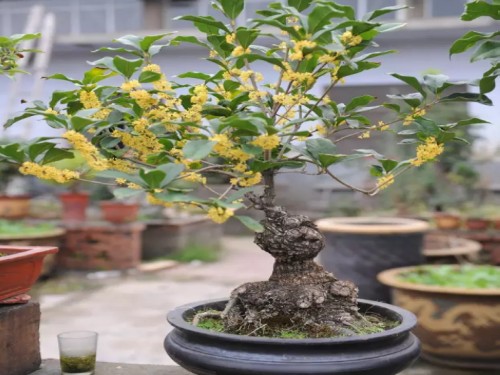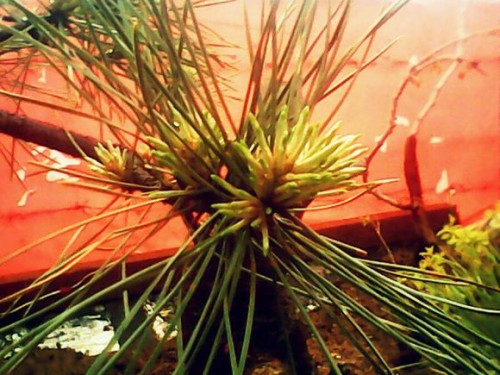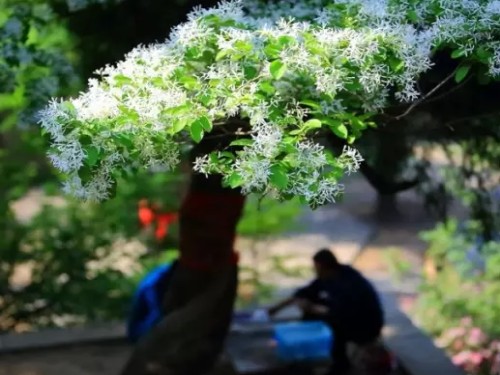Fraxinus chinensis Grafted Osmanthus fragrans Bonsai
Sweet-scented osmanthus is a good tree species for processing bonsai because of its luxuriant branches, evergreen seasons, intertwined roots, beautiful posture, gorgeous flowers and fruits, fragrant flowers, strong sprouting, pruning resistance, long life and other biological characteristics. The production process of sweet-scented osmanthus bonsai is complicated, learning from nature and wonderful. High-level bonsai benefits from the profound artistic conception and skilled techniques of bonsai teachers.
Osmanthus bonsai production principles: far-reaching composition; learn from natural reality; enhance strengths and avoid weaknesses; dynamic and static combination of dexterity; unified coordination and eye-pleasing; small and medium-sized perception; proper density; primary and secondary clear eye-catching.
It is difficult to make and cultivate large-scale sweet-scented osmanthus bonsai in the north. In recent years, sweet-scented osmanthus bonsai grafted by white wax stump is very popular with bonsai lovers. Although ash and sweet-scented osmanthus are different genera, but they are of the same family, they can be grafted to make medium-and large-scale sweet-scented osmanthus bonsai. Now the method of grafting ash tree with sweet-scented osmanthus bonsai is introduced to bonsai lovers for reference.

1. Material selection and cultivation of white wax.
Ash is a deciduous tree of Oleaceae, which is widely cultivated in China. Like the sun, slightly resistant to shade. It can be cultured by sowing, cutting, ramet and striping culture. Ash has strong germination, high survival rate and fast growth, so it is a good material for making grafted sweet-scented osmanthus bonsai. You can use the discarded white wax stump, or go to the nursery to buy suitable for bonsai stumps, cultivate the shape, and then graft sweet-scented osmanthus.
The selection of white wax pile blank is the same as that of other bonsai pile blank, which is suitable for making bonsai pile billet with good body and prosperous growth. After the pile billet is excavated, the big root is cut off and the fibrous root is retained. According to the requirements of bonsai modeling, the necessary branches are left, and the excess branches are removed. According to the situation of pile billet, the ground is planted for 1-2 years. If the root of the pile billet is well fastened, the branch thickness and length are suitable, the excavation can be grafted in the pot in the same year, and the excavation and pot time can be carried out after falling leaves in early winter and before the flow of white wax and sweet-scented osmanthus tree sap in spring.
2. Grafting
Grafting can be carried out from May to August in North China, and the best time is from front to three volts, open-air maintenance, which can be successful in more than two months. When the white wax and sweet-scented osmanthus began to germinate in late March, the grafting was placed in the sunny shed to prevent the wind from losing water. After grafting, the white wax stump will grow new buds and should be cut off in time to prevent the consumption of nutrients. When it is found that the scion is dead, the dead scion should be cut off in time to cultivate new white wax branches, which can be regrafted after cultivation. The survival rate of split grafting method is higher than that of relying on grafting method, and the growth is better. Osmanthus osmanthus scion should select varieties with short branches and dense leaf spacing to make sweet-scented osmanthus branches compact, such as using sweet-scented osmanthus branches with long leaf spacing, to be grafted to survive and grow a number of branches in time to control the height.
Ligustrum lucidum, Ligustrum lucidum and Fraxinus lobularis can be used as rootstocks to be cut from 5 cm above the ground before germination in spring and then grafted by split grafting. Potted sweet-scented osmanthus in northern China can be propagated by grafting in summer, planting lobular privet in pot in early spring, then grafting branches with similar thickness to sweet-scented osmanthus trees, cutting the scion away from the mother and cutting off the branches on the interface of the rootstock at the same time. The high-pressure method was carried out before bud germination in spring. 2-3-year-old branches were selected and propagated with moss and other moisturizing materials after ring cutting.
3. Maintenance and management
White wax and sweet-scented osmanthus have different habits, both should be taken into account in maintenance management, especially in winter management, if there is any mistake, all previous efforts will be wasted. There are two main problems in winter management, one is to ensure temperature, the other is to prevent wind. The sweet-scented osmanthus bonsai grafted with white wax should be placed in a sunny shed with a temperature of not less than 0 ℃ in winter, so that the grafted sweet-scented osmanthus can not be frozen and blown by the wind, so that the grafted sweet-scented osmanthus can survive the winter safely, but the temperature should not be too high, which will prevent the stump and branches of sweet-scented osmanthus from dormancy. Spring out of the shed time is not too early, too early wind blowing, the air is dry, sweet-scented osmanthus branches, especially the interface will be affected, can take a gradual approach to open the shed, until all open.
Potted sweet-scented osmanthus to the autumn of the second year to change the pot, the pot to tile jar or larger tile pot is appropriate. When changing the basin, do not damage the roots, remove part of the persistent soil, replace it with new culture soil, and put in a small amount of base fertilizer. When planting, you should pay attention to make the root system spread in the basin and not nest in one place. After planting, shake the flowerpot so that the culture soil is in close contact with the root system, and then water it once. When Frosts Descent, place the pot indoors. In the early stages of potting and changing pots, do not water too much to prevent rotting roots. The indoor temperature should be kept at 5-10 ℃, too high temperature is not conducive to hibernation, will produce leaf buds and weak branches, affecting the normal growth and development after the next spring; if the temperature is low, it is vulnerable to freezing injury.
Note:
1. Sweet-scented osmanthus likes slightly acidic soil.
Pot culture can choose 5 parts of mountain mud, 3 parts of humus soil, 2 parts of sandy soil or half of rotten leaf soil and sandy loam soil as culture soil. If the soil is too acidic, the growth is slow and the leaves are withered and yellow. If alkaline soil is used, it can lead to leaf withering and even death after 2-3 months.
2. Watering should be timely.
Sweet-scented osmanthus watering should master "two less and one more", that is, less watering before the occurrence of new shoots, less watering in rainy days, and more watering in dry weather in summer and autumn. Usually watering is appropriate to keep the water content of the basin soil about 50%. Drainage should be carried out in time on cloudy and rainy days to prevent stagnant water in the basin from rotting roots, otherwise it is easy to "drown".
3. Skillfully applying topdressing
Sweet-scented osmanthus likes pig dung. As the flower proverb goes, "if you want the fragrance of sweet-scented osmanthus, prepare more pig manure tanks." If the rotten and thin pig manure is applied once every 10 to 15 days from April to May, once every 10 to 10 days from June to July, and the last time at the beginning of August, the sweet-scented osmanthus will grow luxuriantly, bloom more and taste fragrant. There is no pig manure in the city, so rotten cake liquid can be used. If there is not enough fertilizer, there will be fewer branches, fewer flowers, and no fragrance.
4. Proper pruning
Adult sweet-scented osmanthus trees shoot twice a year. Therefore, in order to make sweet-scented osmanthus blossom flourish and need proper pruning, it is generally necessary to cut off overgrown branches, thin and weak branches, disease and insect branches, so as to facilitate ventilation and light, concentrate nutrients, and promote sweet-scented osmanthus to breed more and bloom luxuriantly.
Time: 2019-05-26 Click:
- Prev

Production method of Pinus tabulaeformis bonsai
Pinus tabulaeformis tall and straight, evergreen, long life, not afraid of wind, snow and cold, people regard it as a symbol of unyielding and longevity. The posture of Pinus tabulaeformis is ever-changing, and the older it is, the more strange it is, so it is an ideal material for making bonsai. After Pinus tabulaeformis is planted, water is applied twice in a week, then the soil can be loosened, the soil moisture can be preserved, and it can be watered again in early May.
- Next

Tassel grafted osmanthus bonsai
Tassel, also known as April snow or shredded radish flowers, is in full bloom every early summer, covered with white flowers, such as frost and snow. Tassel flower, white and flawless, like a fairy who does not eat human smoke and fire, detached from the dust. Beautiful flowers, such as the ancient ladies dress tassel, hence the name, very beautiful, both elegant and holy
Related
- Fuxing push coffee new agricultural production and marketing class: lack of small-scale processing plants
- Jujube rice field leisure farm deep ploughing Yilan for five years to create a space for organic food and play
- Nongyu Farm-A trial of organic papaya for brave women with advanced technology
- Four points for attention in the prevention and control of diseases and insect pests of edible fungi
- How to add nutrient solution to Edible Fungi
- Is there any good way to control edible fungus mites?
- Open Inoculation Technology of Edible Fungi
- Is there any clever way to use fertilizer for edible fungus in winter?
- What agents are used to kill the pathogens of edible fungi in the mushroom shed?
- Rapid drying of Edible Fungi

